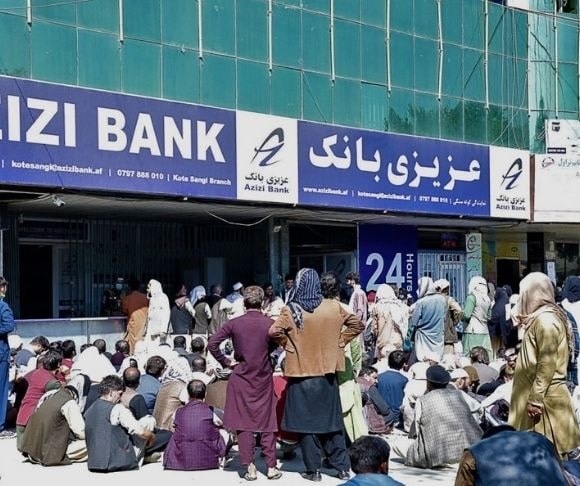Coalition forces spent two decades in Afghanistan, building a nation from rubble after conquering the Taliban. The United States, facing trillions of dollars in debt, allocated $2 trillion to the Middle Eastern country, deficit-financed money that was consumed to construct a military apparatus, build infrastructure, and establish a strong economy. Today, the Afghan armed forces no longer exist, the bridges have crumbled, and the economy is on the brink of collapse. Now that America has waved goodbye militarily to Kabul, the world can ask: What was it all for, anyway?
The Countdown Begins
 According to the consensus among many international observers, it is inevitable that Afghanistan’s economy will spiral out of control, eventually leading to a national calamity. It comes down to one thing: Afghanistan is running out of cash. This has forced families to survive on tea and small servings of bread, a situation which could metastasize into a humanitarian crisis. At this point, the only way Afghanistan could be resuscitated is with assistance from China and Russia. These countries have already stepped in, pledging tens of millions of dollars’ worth of aid, including food and coronavirus vaccines. But the politically related bailout might not be enough to tackle the fundamental problems in Afghanistan.
According to the consensus among many international observers, it is inevitable that Afghanistan’s economy will spiral out of control, eventually leading to a national calamity. It comes down to one thing: Afghanistan is running out of cash. This has forced families to survive on tea and small servings of bread, a situation which could metastasize into a humanitarian crisis. At this point, the only way Afghanistan could be resuscitated is with assistance from China and Russia. These countries have already stepped in, pledging tens of millions of dollars’ worth of aid, including food and coronavirus vaccines. But the politically related bailout might not be enough to tackle the fundamental problems in Afghanistan.
A Financial Crisis in the Beginning
While the Taliban takeover exacerbated the country’s problems, the Afghan economy was already descending into a substantial financial crisis. To put it into context, 40% of its gross domestic product (GDP) was entirely dependent on foreign aid. Now that the world has closed its wallet to Kabul, the economic system is breaking down. The Taliban might pray for another occupation, if only for the dollars and euros to flow through the market.
Multiple segments of the economy, particularly the financial sector, are facing an “existential crisis,” says Syed Moosa Kaleem Al-Falahi, the chief executive of the Islamic Bank of Afghanistan. As a result, people are only making withdrawals and refraining from depositing any funds. Banks are not offering the most basic of services, and any assets the government possesses overseas have been frozen. The Taliban-controlled central bank has attempted to alleviate the dire situation by pleading with the International Monetary Fund (IMF) and the U.S. Treasury to release funds that the government owns. But nobody has acquiesced to the terrorist group’s request.

(Photo by Stringer\TASS via Getty Images)
Foreign money had financed the nation’s enormous trade deficit and public expenditures. In recent years, Afghan exports cratered, and imports tripled. As the government begins to put together a national budget, it will be challenging for the Taliban to raise the necessary revenue to reduce joblessness, pay the salaries of civil servants, and cover the cost of elementary administration. Experts prognosticate that Kabul will need a minimum of $5 billion per year just to run the essential components of the government.
Even if the government and population had access to capital, it would not matter because of two inherent hurdles: a currency crisis and rampant price inflation. The afghani has plummeted, resulting in the near evisceration of its value against the buck, loonie, pound, euro, and every other advanced currency on the planet. Price inflation could lead to economic ruin as consumers do not have access to essential items. It is estimated that 97% of Afghans could slip into poverty. The unemployment rate is much higher than before the Taliban seized control, and households are selling everything they have to afford the little food supply available.
Jan Egeland, secretary-general of the Norwegian Refugee Council, said in a statement:
“If the economy collapses, even the most basic services will no longer function, and humanitarian needs will soar even higher. Dealing with the liquidity crisis is critical as aid organisations seek to scale up to meet urgent humanitarian needs.
We are in a race against the clock to save lives before the harsh winter arrives and temperatures drop to as low as minus 20 degrees Celsius. Hundreds of thousands of displaced people urgently need shelter, warm clothes and food in the coming weeks. Already, one in three Afghans do not know where their next meal will come from.”
Will Reforms Come to the Taliban Economy?
Despite the myriad promises of equal rights for women and girls and a more inclusive society, reports suggest that the reality on the ground is vastly different. Adult women are not allowed to go to work, while young girls are not attending school. If the Taliban wishes to tap into potentially billions of dollars in reserves held overseas, the Taliban 2.0 will need to, even if out of sustenance, showcase a more neoteric and reformed Afghanistan to the world. Will its regressive and repressive nature make such concessions for capital? Warlords might have already learned that they could grow as hungry for power as for food, even if it means performing the greatest sin of them all: empowering women.
~ Read more from Andrew Moran.




